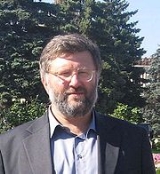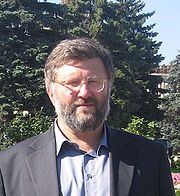
Dmitri Capyrin
Encyclopedia

Contemporary classical music
Contemporary classical music can be understood as belonging to the period that started in the mid-1970s with the retreat of modernism. However, the term may also be employed in a broader sense to refer to all post-1945 modern musical forms.-Categorization:...
. He graduated from Lviv Conservatory
Lviv Conservatory
The Lviv National Musical Academy, M. Lysenko is a state conservatory of Ukraine based in Lviv.-History:...
in 1984. He lives in Moscow and works as a freelance composer. His music "successfully combines a variety [of] techniques, often using literary sources and motifs in his works." He won the second prize in the 1994 ICONS competition in Turin
Turin
Turin is a city and major business and cultural centre in northern Italy, capital of the Piedmont region, located mainly on the left bank of the Po River and surrounded by the Alpine arch. The population of the city proper is 909,193 while the population of the urban area is estimated by Eurostat...
and received a scholarship in 1995 from the Berlin Akademie der Künst. In 2010 he was the finalist of the YouTube Online Composers Competition. His compositions have been performed by "numerous prominent ensembles and soloists, and has also been featured in a variety of concert and festival venues, including the Moscow Autumn (1999), the Paris Presences (1993), Warsaw Autumn
Warsaw Autumn
Warsaw Autumn is the largest international Polish festival of contemporary music. Indeed, for many years, it was the only festival of its type in Central and Eastern Europe. It was founded in 1956 by two composers, Tadeusz Baird and Kazimierz Serocki, and officially established by the Head Board...
(2005) and the Music Biennale Zagreb
Music Biennale Zagreb
Music Biennale Zagreb is an international festival of contemporary music in Zagreb, Croatia, organized by the Croatian Composers' Society. The Biennale, founded by Milko Kelemen and held every spring of the odd years since 1961, has become one of the most important festivals of contemporary music...
(1993, 2011)." He has become "one of the most prominent composers of the younger generation of Russians." His style combines modal scales procedures with new tonal and atonal idioms. He prefers polyphonic texture and dense stratification of flexible melodic voices. At the same time he widely uses isolated tones and brief solo phrases surrounded with silence which resembles quasi-Webernian pointillism
Pointillism
Pointillism is a technique of painting in which small, distinct dots of pure color are applied in patterns to form an image. Georges Seurat developed the technique in 1886, branching from Impressionism. The term Pointillism was first coined by art critics in the late 1880s to ridicule the works...
. His work list includes pieces of various genres from opera
Opera
Opera is an art form in which singers and musicians perform a dramatic work combining text and musical score, usually in a theatrical setting. Opera incorporates many of the elements of spoken theatre, such as acting, scenery, and costumes and sometimes includes dance...
, symphonies
Symphony
A symphony is an extended musical composition in Western classical music, scored almost always for orchestra. A symphony usually contains at least one movement or episode composed according to the sonata principle...
and one movement poems
Symphonic poem
A symphonic poem or tone poem is a piece of orchestral music in a single continuous section in which the content of a poem, a story or novel, a painting, a landscape or another source is illustrated or evoked. The term was first applied by Hungarian composer Franz Liszt to his 13 works in this vein...
for full and chamber orchestras, concerto
Concerto
A concerto is a musical work usually composed in three parts or movements, in which one solo instrument is accompanied by an orchestra.The etymology is uncertain, but the word seems to have originated from the conjunction of the two Latin words...
s for harp
Harp
The harp is a multi-stringed instrument which has the plane of its strings positioned perpendicularly to the soundboard. Organologically, it is in the general category of chordophones and has its own sub category . All harps have a neck, resonator and strings...
and oboe
Oboe
The oboe is a double reed musical instrument of the woodwind family. In English, prior to 1770, the instrument was called "hautbois" , "hoboy", or "French hoboy". The spelling "oboe" was adopted into English ca...
with orchestra, pieces for various chamber ensembles, duo and solo works. Among the performers of his music there are Yvar Mikhashoff
Yvar Mikhashoff
Yvar Emilian Mikhashoff was an American virtuoso pianist and composer...
, Claude Delangle
Claude Delangle
Claude Delangle is a French classical saxophonist. He teaches saxophone at the National Superior Conservatory of Music of Paris since 1988. He played in the famous "Quatuor Adolphe Sax Paris" with Jacques Baguet, Bruno Totaro an Jean-Paul Fouchécourt. Very implicated during the 80's in developing...
, Marc Sieffert, Valery Popov
Valery Popov
Valery Popov may refer to:* Valery Popov , Soviet and Russian diplomat and ambassador* Valery Popov , Soviet bassoonist...
, Moscow Contemporary Music Ensemble, Russian National Orchestra
Russian National Orchestra
The Russian National Orchestra premiered in Moscow in 1990.It was the first Russian orchestra to perform at the Apostolic Palace, Vatican and in Israel....
, Ensemble Kyiv Sinfonietta, Da Capo Chamber Players
Da Capo Chamber Players
Da Capo Chamber Players is an American contemporary music "Pierrot ensemble," founded in 1970. Winners of the Naumburg Award in 1973, its founding members included composer/pianist Joan Tower, violinist Joel Lester, Dean of Mannes College of Music, and flutist Patricia Spencer...
.
External links
- Dmitri Capyrin Official website
- Dmitri Capyrin sheet music

